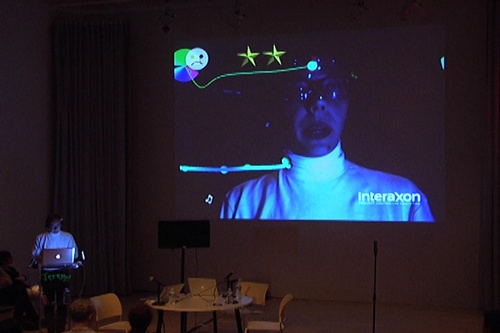Life Feed: New Works by Jeremy Bailey and Antoine Catala
In 2011, the New Museum presented Life Feed: New Works by Jeremy Bailey and Antoine Catala, organized by Rhizome as part of the New Silent series. Bailey and Catala are two artists who had both taken an interest in the webcam as a medium and a subject, from divergent perspectives. Bailey had been experimenting with thought-controlled technology: devices that respond to readings of their users’ brain waves might satirize art-critical clichés about the uniqueness of the artist’s mind, and future telecom technology could result in works that make the artist’s process transparent. Catala, meanwhile, was interested in the emerging format of lifecasting - non-stop all day transmission of oneself via a webcam. He believed that lifecasting represented the movement of broadcast technology from the professional artist’s studio to the home, as well as a form of constant self-design and performance. Bailey is thinking about what can and can’t be shown and shared. Catala’s interests lie in what is visible, and teasing out the nature of reactions to it. Both artists approach the psychological state of the webcam: creating a reflection of the self, and generating human feedback by offering that reflection as a beacon for multiple, unknown others.
Bailey’s webcam works of the preceding five years posed similar questions about technology’s limits. His exaggerated on-screen persona — “I’m Jeremy Bailey, the famous new media artist!” — heralded new art forms that would transcend the human body with computers. He imagined the dance of the future and the theater of the future. But in the gap between gushing words and goofy visuals, viewers could see how the prosthetically enhanced arts were poorer than their analogue predecessors.
The artist had recently moved toward an exploration of vulnerability, asking not what technology obscures or deletes, but what it can expose. Bailey reimagines programming as a kind of drawing, with drawing - as the cliché of art criticism has it - being the most expressive and open of mediums, a record of the immediate contact between the artist’s body and the surface he’s working with. Thought-controlled computing, a technology provided to him by the Canadian company Interaxon, allowed him to draw on the screen with a “brush” controlled by the computer’s reading of how focused or relaxed his mind was.
Telecom devices may be prostheses, enabling the body to expand its activity in new directions, but thought-controlled computing lets a machine take on the human function of recognizing the emotional state of the other. This suggests an ambiguous future for communication, one that can look especially raw in a live performance, where Bailey’s own mental state hinges on the laughter and silence of the audience before him.
In 2009, Antoine Catala made a series of sculptures by painting on the screens of television sets and letting them run. He juxtaposed a naive gesture to a piece of mass-produced technology and its professionally produced broadcasts. Lifecasting drew his interest because, like television, it can serve as a kind of moving wallpaper, but it incorporates naive gestures with the content on the screen, both in the lifecaster’s performance and her viewers’ running commentary in the adjacent chat box. The looping communication— the presentation of a persona, the anonymous commentary responding to it, and the persona’s self-adjustment in response to the response— led Catala to think more deeply about his own presentation of self online and perceptions of him based on the data available, and how to communicate his observations through drawings and performance.
The New Silent was a series of programs, presented by the New Museum and organized by its affiliate organization Rhizome, that explored contemporary art engaged with emerging technology and examined the ways digital technologies alter our lives and experiences of urban spaces. The series comprised screenings and performances, as well as a critical conversational strand, which brought together leading scholars, artists, critics, and public figures to illuminate the complex interactions between technology, culture, and creative practice. Named for the generational theories of Neil Howe and William Strauss, the New Silent presented artists working at the furthest reaches of technological experimentation as well as those responding to the broader aesthetic and political implications of new tools and media.
